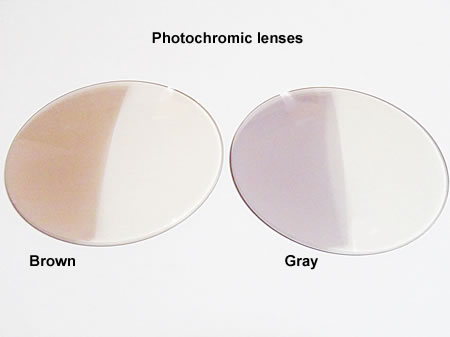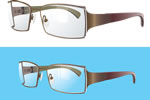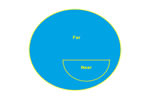The Advantages of Photochromic Lenses
Photochromic lenses due to its properties are part of the UV sun protection lenses. They are known also as transition, due to reputation of a company that produces them, but the real name for lenses with such properties is photochromic lenses.
Compared with colored lenses, they are more beneficial for someone who needs prescription glasses:
Colored lenses vs. photochromic lenses
A sunscreen colored lens is characterized by the fact, it has a simple coloration between 10% and 85% that remains the same regardless of light intensity. For example, a lens coloration of 85% is suitable for strong sunlight.
But what if it gets cloudy or the night comes? Lens will be too dark for normal vision so glasses will be inadequate and even disturbing.
For this reason appeared the photochromic lenses that have property to change their color, depending on light intensity.
Below, half of the lens was exposed to the sun, and the other half was not. See the difference:
How photochromic properties work
If you are home, the lenses are transparent white.
Outside if is cloudy they have a coloration between 20%-60% and then coloring reaches up to 80% if sunlight is strong. So you have different colors for different intensities of light in a single lens.
The length of time the lens goes from 10% to 85% coloration in bright sunlight is about 30 seconds, instead reverse, from 80% to 10% it takes a few minutes.
I have to admit that photochromic glasses are the most successful innovation in this field of UV eye protection, a hugely appreciated innovation in our store.
Helpful Tips
- The usually photochromic glasses will NOT darken in the car because windshields are equipped with UV protection. To darken in the car, you want to apply for particular driving photochromic glasses
- If you have broken one lens, I suggest you change both lenses if you want to have the same shade of color
- When you choose a frame for such lenses, in the store ask your optician to darken the lenses (there is an UV machine for that), so you can see the lens color that you want for best match with the frame color
Technologically speaking there are two types of lenses with photochromic properties:
Lenses with photochromic coating
This is a foil on the lens and because of its high resistance and quality is the most popular and often used (ex. photochromic lenses). The only disadvantage is that, after a few years, its photochromic proprieties will decrease and will be less efficient and attractive.
Photochromic coating can be applied to any existing lens material: glass, plastic, polycarbonate. Can be used in combination with any of the usual treatments for lenses: anti-reflective coating, hardening…
The photochromic lenses
Here, the photochromic part is the lens itself, which is molded with these properties. This technology is used for high index lenses. This keep them thin after different proprieties are added.
The advantage is that, in time, they don't reduce their proprieties. As the material, they can be made of glass, plastic, polycarbonate.
You have to know that this type of lenses are available in various colors:
- Brown: relaxing and a pleasant tone. I recommend it to those who don’t wear dark sunglasses because they darken too much the image
- Gray: a dark color reduces sunlight and brightness. I suggest it to those who have advanced photophobia, so have increased discomfort from bright sunlight
- Green: this color is rarely used. It says that green is the color that relaxes the eyes. It is used primarily by athletes for not exceeding darker image but restful for the eyes
Personally, I like phtochromic lenses, I wear a pair of such eyeglasses, and I'm pleased with them.
If you are a person sensitive to sunlight and wearing glasses for vision correction, I can not think of a better option than this type of lens that changes color, depending on daylight intensity.
Quick Links - Eyeglass Lenses
Home » Eyeglass Lenses » Photochromic Lenses
Was this information useful?
1. Like Perfect-Eyeglasses-Guide.com on Facebook.
2. Share this article with your friends:













